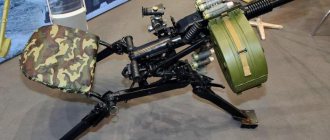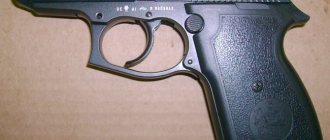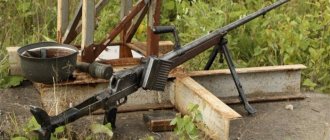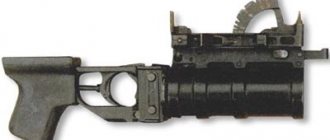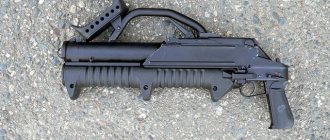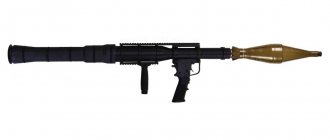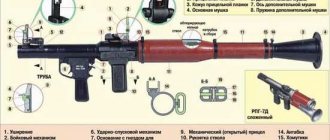Weapons of World War II: PIAT anti-tank grenade launcher
During the Second World War, the first anti-tank grenade launchers were created and brought to practical use in several countries around the world. Various weapons of this class used some common ideas, but differed in certain features. One of the most original versions of the anti-tank grenade launcher was the PIAT product, created by British gunsmiths. Having noticeable differences from foreign models, such a grenade launcher showed acceptable effectiveness and was of interest to the troops.
The reasons for the appearance of the new model anti-tank grenade launcher were simple. At the initial stage of the Second World War, the British infantry had only two means of combating enemy tanks: the Boys anti-tank rifle and the No. 68 rifle grenade. Such weapons were used quite actively for a long time, but their effectiveness was constantly falling. Over time, the gun and grenade almost completely lost their potential in combating enemy armored vehicles and could no longer be considered as full-fledged anti-tank systems. The army needed some new weapon, the characteristics of which would meet the requirements of the time.
General view of the PIAT grenade launcher. The grenade is installed, there is a bipod.
By this time, British gunsmiths had managed to accumulate some experience in the creation of anti-tank weapons. So, since 1940, Lieutenant Colonel Stuart Blacker has been working on a “bombard” of his own design. The Blacker Bombard product was supposed to damage enemy armored vehicles using high-explosive ammunition of the appropriate power, but this seriously limited the characteristics of the weapon. Having learned about developments in the field of cumulative ammunition, S. Blacker proposed a new version of his weapon, characterized by a simplified and lightweight design. By reducing the size and weight, the new weapon could be fired from the shoulder.
Through the efforts of Lieutenant Colonel Blacker, the original design of a promising weapon was formed, which involved launching anti-tank ammunition using a guide-chute and a propellant powder charge. In addition, the project proposed some ideas and solutions regarding other features of the weapon design. By analogy with the previous project, the new weapon received the working name Baby Bombard.
The first version of the hand grenade launcher was developed by mid-1941. In the summer, we produced a prototype weapon and a certain amount of test ammunition for it. During testing, it was found that the proposed design of the weapon and projectile did not meet the operational requirements. First of all, problems arose with the fuses: they did not work, which is why the grenades had no effect on the target.
Partial disassembly of the grenade launcher; the mainspring, firing pin and butt plate were removed from the body.
After the failure of the Baby Bombard project, S. Blacker was transferred to a new job, and the further development of this weapon was entrusted to Major Millis Jeffries. It was Major Jeffreys who completed the development of the original project and improved the grenade launcher, which allowed it to pass all the necessary tests and become a weapon of the British infantry. It should be noted that the change in the project developer subsequently became a cause for controversy. The military department later had to resolve the issue of remuneration for the two designers. Both officers had a direct connection to the creation of the new project, and therefore could count on receiving the due bonus. By the time S. Blacker left the project, 50 thousand pounds sterling (about 1.95 million in current prices) had been spent on work. Later, after the grenade launcher was put into service, the lieutenant colonel received an additional bonus of 25 thousand (973 “modern” thousand).
Initially, the promising grenade launcher had the working name Baby Bombard, which referred to the previous project of Lieutenant Colonel Blacker. After his transfer to another design organization, a new name appeared - Jefferis Shoulder Gun. Having adopted the grenade launcher, the army gave it its own name. Now it was officially called PIAT (Projector, Infantry, Anti-Tank - “Infantry Anti-Tank Grenade Launcher”). Interestingly, at the beginning of 1943, the official name of the weapon was criticized by Winston Churchill himself. The Prime Minister demanded to explain why the new weapon was named by a faceless abbreviation, and not by the name of the designer. However, the weapon was not renamed and, as a result, it became widely known under the official name PIAT.
In the early stages of development, the promising grenade launcher was considered as a deep modernization of the Blacker Bombard, characterized by reduced size and weight. Subsequently, the ideas of the original project underwent serious changes, as a result of which the PIAT product lost any noticeable resemblance to the basic design. In fact, the only idea that transferred from the older project to the new one was the use of the so-called. stock ammunition: PIAT grenades had to have a tubular shank that interacted with the grenade launcher guide rod.
Complete disassembly.
The basis of the design of the PIAT grenade launcher was a tubular body, inside of which the automation parts were placed. Other units were connected to it outside. The case had a diameter of 83 mm, and a guide channel was attached to it in front, made in the form of a pipe with a missing upper section. This device was intended to hold the grenade in the required position and prevent damage. The clamp connecting the gutter and pipe had fastenings for mounting a bipod. At the bottom of the body was attached the housing of the trigger mechanism with a characteristic croup bracket. There were sighting devices on the left surface of the pipe. The rear end of the body was covered with a butt plate.
The internal structure of the grenade launcher was quite simple. The front end of the body had a round cover, in the center of which there was a tubular rod. The needle striker of the firing pin had to move inside this part. The striker itself was made in the form of a massive metal cylinder with a needle striker at the front end. The rear end of the firing pin was supposed to interact with the mainspring. On its lower surface there was a recess for interaction with the sear. The drummer had a mechanical connection with a rod connected to the butt plate. With the help of this rod it was proposed to cock the mechanisms.
Penalty grenade launcher
The 40-mm hand-held disposable grenade launcher “Penal” was developed in the late 1970s by Valery Nikolaevich Telesh. The “Penal” hand-held disposable grenade launcher is intended, under certain circumstances, to replace a hand grenade (which, as is known, can be thrown at most 30-40 m). Outwardly, the “Pencil” actually resembles a schoolboy’s equipment, but it allows you to throw the VOG-25 at 100-300 m.
The Penal grenade launcher is a rifled thin-walled aluminum barrel without a sight, in the middle part of which there is a breech with a simple impact mechanism. A VOG-25 (VOG-25 P) shot or a shot with a bird cherry is inserted in front; at the back there is a countermass - aluminum or plastic plates that are thrown out, reducing recoil.
The Penal striker is cocked in advance and stands on a safety pin - again, like a hand grenade. The ends of the barrel are closed with easily destructible sealed caps.
Before firing, you just need to remove the safety pin, move your hand with the “Pencil Case” to the side so as not to catch yourself and your neighbors with the flying countermass, aim it at the target, set the elevation angle according to the remote scale and press the trigger lever. No special precision is required, the main thing is the damaging effect of the fragments.
The cost of manufacturing a grenade launcher is not much higher than the cost of manufacturing a shot for an under-barrel grenade launcher, but this grenade launcher allows you to hit targets at a range of up to 300 m.
The “pencil case” can be used to shoot not only combat grenades, but also grenades filled with the irritating toxic substance CS or rubber bullets.
